U.S. Coast Guard awards contract for first new heavy icebreaker in four decades
Mississippi-based VT Halter Marine Inc. will design and construct the new U.S. heavy icebreaker, with the option of building two more.

The U.S. Coast Guard has awarded a contract to VT Halter Marine Inc. to design and construct the first U.S. heavy icebreaker in decades.
The company, which is based in Pascagoula, Mississippi, will receive $745.9 million for the engineering, design and construction of the polar security cutter. The contract also includes the option to build two more cutters, for a total of $1.9 billion.
Construction on the new heavy icebreaker will begin in 2021. Although the contract specifies delivery in 2024, it includes financial incentives for finishing earlier. If the construction of the other two heavy icebreakers is confirmed, the work will extend until November 2027.
The U.S. Coast Guard currently has two operational icebreakers. The Healy, a medium-class vessel commissioned in 1999, is used primarily for scientific research. The Polar Star, a heavy icebreaker first commissioned in 1976 and overhauled in 2012, conducts the annual breakup to McMurdo Station in Antarctica and spends much of the remaining year being repaired in a dry dock. The Polar Star has broken down several times on the last two missions to Antarctica.
Adm. Karl L. Schultz, commandant of the Coast Guard, highlighted security concerns as a driving factor for building more ice-capable vessels.
“Against the backdrop of great power competition, the Polar Security Cutter is key to our nation’s presence in the polar regions,” he said in a statement. Schultz reiterated the need for a “full complement of six polar icebreakers” to complete missions in the Arctic and the Antarctic, especially considering expected growth in commerce, tourism, research, and international activities in the polar regions.
The Coast Guard’s Arctic Strategic Outlook, released on Monday, also calls for increased investments in the circumpolar north, highlighting in particular the rapid changes in the physical environment, geopolitics and economics and the agency’s increasing presence as a result.
The polar security cutter program has received about $1 billion in funding in the past two years, through both the Coast Guard’s procurement account and the Navy’s shipbuilding account. The two agencies are working together on procuring the ice-class vessels.
James Geurts, Assistant Secretary of the Navy for Research, Development and Acquisition, highlighted the benefits of the Navy and the Coast Guard working together. “Working with our industry partners, the team identified approximately $300 million in cost avoidances and accelerated the schedule for delivery of this capability to the nation by almost three years,” he said in a statement.
“The first ship will cost more than the other two because it will incorporate design costs for the class and be at the start of the production learning curve for the class,” Ronald O’Rourke, an analyst for the Congressional Research Service, wrote in a recent background report on the polar security cutter program. The U.S. has not designed a heavy icebreaker since the 1970s, and many of the technologies have changed since then.
The Coast Guard included another $35 million in its 2020 budget request to continue working toward another heavy icebreaker.